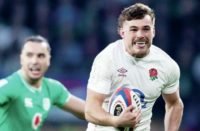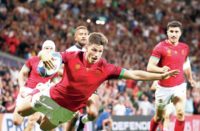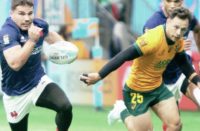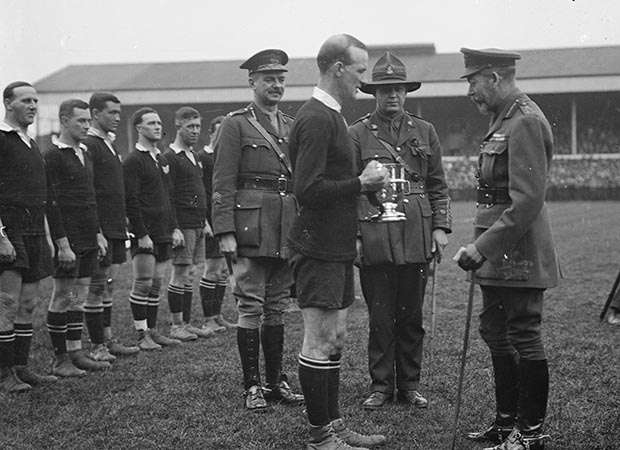 The road not taken is an enduring theme in sport and now, right in the middle of a riotously successful World Cup, it's galling to think that a template of sorts was in place for a global competition nearly 100 years ago. The King's Cup in 1919 was a massive trailblazing event but it was 68 years before the strictly amateur world of Rugby Union fanned the embers of that competition and came up with the 1987 World Cup which in turn has morphed into the huge event we are currently enjoying.
The road not taken is an enduring theme in sport and now, right in the middle of a riotously successful World Cup, it's galling to think that a template of sorts was in place for a global competition nearly 100 years ago. The King's Cup in 1919 was a massive trailblazing event but it was 68 years before the strictly amateur world of Rugby Union fanned the embers of that competition and came up with the 1987 World Cup which in turn has morphed into the huge event we are currently enjoying.
To set the scene, it's early 1919 and garrisoned around Britain and Northern Europe are hundreds of thousands – more than likely millions – of allied troops from Britain and the Dominions. Tired certainly and some scarred for life but those who survived were resilient and, as peace became a reality, their strength and energy returned and they needed an outlet as they waited to be demobbed.
These troops were from all over the world but we are concerned with those from England, Wales, Scotland, Ireland, New Zealand, South Africa, Australia, Canada and – late in the story – France.
Included in their ranks was just about any rugby player of note from that generation – past internationals, future internationals and those who War robbed of their rightful sporting glory, although that statement comes with a sombre caveat – 137 Test caps had been killed in hostilities including some of the biggest names in the sport's history – Ronnie Poulton-Palmer, Dave Gallaher, David Bedell Sivright and Blair Swannell.
Rugby had enjoyed an outstandingly ‘good' War if such a thing was possible; its players conspicuously leading the way when volunteering for duty and mostly proving to be outstanding soldiers in the field. It had usurped soccer as the sport of choice in the Services and found much favour with all the ‘top brass' and indeed Royalty, George V being a big fan.
It was also the Empire's winter sport of choice with New Zealand, Australia and South Africa all showing a great aptitude for the sport.
So, back to shell-cratered northern Europe with all those fit youngish men waiting interminably for their discharge and the boat home. What to do? Sport of course, from dawn to dusk. Firstly at company and divisional level and then representing the Service itself. And when it comes to rugby we are talking a serious level of ability, what more they were able to live the professional life 76 years before it was official permitted.
For one blissful season their lives consisted of reveille, breakfast, sport, lunch, sport, evening meal, drinks down the mess or local pub, lights out. Other than the Navy, who were busy repatriating the millions, clearing mines and helping naval commerce back on its feet, duties were light in the extreme.
So the King's Cup was born although first it was called the Inter-Services Rugby competition before the King donated the trophy. The New Zealand, Australia and South Africa Armed Forces were invited to select their best teams – the first two named were already embarked on extensive tours of Britain, building on teams they had first formed in the mud of Flanders during hostilities.
The Canadians were also invited because, despite no great prowess at rugby, they had proved excellent soldiers and were immensely popular. And, perhaps, the experience could improve their game.
Much of this story is covered in the latter stages of After The Final Whistle by Stephen Cooper, the author of the acclaimed Final Whistle where he looked at the World War I exploits of 15 selected members of Rosslyn Park. His latest book expands that theme to rugby players from all the allied nations and concludes with the staging of the King's Cup.
The original intention for the tournament had been for the British Army, Navy and RAF to form teams as well but the hard-pressed Navy backed out. The British Army team was then renamed the Mother Country and took in all serving soldiers from England, Scotland and Wales and Ireland as well as the many Irish who served in the British Army.
That is some gathering of talent and the original concept was political as well as sporting. These sons of Empire had won the bloodiest of Wars and the tournament was in many ways a lap of honour for all concerned but there were also political nuances.
The Dominions were both being recognised for the independent nations that they were while at the same time their close blood and cultural ties were emphasised.
The New Zealand Army, in the middle of a 38-match tour of Britain, unsurprisingly for a team with seven past and six future All Blacks, won the tournament and boasted a squad so powerful that on three occasions they put out a B-team and defeated strong clubs in Wales on the same day as they contested King's Cup matches.
After beating the Mother Country in the Twickenham final they defeated the French Army in a special challenge at Twickenham – the French has been specifically excluded from the Dominions party – and as if to prove their worth the NZ Army team then defeated a full-strength Wales national team in Cardiff.
Some of the teams were chalk and cheese. New Zealand boasted two commissioned officers – the rest being sergeant majors or privates. That contrasted with the Mother Country squad of 21 that included 20 commissioned officers, one sergeant-major and no private soldiers.
Much of the interest in the tournament did, however, centre on the colourful cast of heroes. The RAF were an inconsistent bunch who cheerfully lurched from highs to lows, possibly depending on how good the festivities had been the previous week. Just months before servicemen had lived with the daily threat of death and now in peacetime there was much living to do.
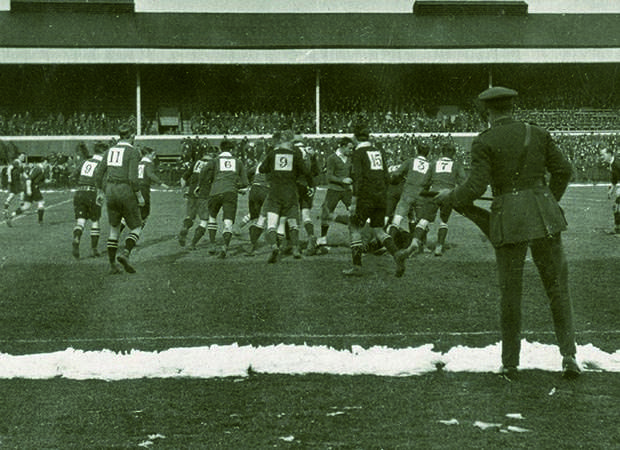 At times they could put out a strong and distinctly eclectic XV. A young Wavell Wakefield – 20 – had, to his chagrin, just missed out on hostilities after training as a pilot and had been stationed at Scapa Flow when he was recalled to organise the RAF team. Even then his outstanding ability as a player and galvanising force had been picked up by his superiors.
At times they could put out a strong and distinctly eclectic XV. A young Wavell Wakefield – 20 – had, to his chagrin, just missed out on hostilities after training as a pilot and had been stationed at Scapa Flow when he was recalled to organise the RAF team. Even then his outstanding ability as a player and galvanising force had been picked up by his superiors.
The RAF embarked on a short tour of Belgium and France to play military units and scout for rugby talent among far-flung squadrons. Fighter pilot and England wing sensation Cyril Lowe was, alas, unavailable but Scotland internationals George Thom and Archie Symington were extremely useful players and a large contingent of South Africans, who had volunteered for flying duties, ensured some strength in depth.
There were some real mavericks as well, though. Throughout the Services generally there were seemingly cordial relations with the many outstanding Rugby League men who joined up and were allowed to play Union by special RFU dispensation from 1916 onwards. But only Wigan's Billy Seddon played in the King's Cup.
Seddon kicked the RAF's winning goal in their sensational 7-3 win over Australia, a dropped goal being worth four points at the time. His presence in the RAF team was probably down to two factors. First, as a skilled engineer he had been granted a commission and promoted to lieutenant and was considered one of the ‘chaps' and, second, the wildly ambitious and competitive Wavell Wakefield recognised a class player when he saw one. Wakefield was not a man who let red tape get in his way.
A certain “Taffy” Jones, of Carmarthen Harlequins, made a solitary appearance on the wing in their 22-3 defeat against New Zealand at St Helen's where, according to contemporary reports, he looked dangerous although he was rather starved of the ball. The small squat figure on the left flank was better known as James Ira Thomas Jones DSO, MC, DFC and bar, MM – one of the most feared pilots of the War who finished hostilities with 37 confirmed kills in barely three months despite not being commissioned as a pilot until August 1917.
Originally Jones had enlisted in the Territorial Army, switched to the newly-formed RAF and won his MM as an air mechanic before becoming a gunner and observer. Finally his fighting spirit was fully recognised by ‘top brass' and he qualified as a pilot before ending the War as a commanding officer of 74 squadron. It was a remarkable climb up the ladder in a very elitist Service but Jones never forgot his working class farming roots as he remarks in an oft-quoted passage from his autobiography:
“My habit of attacking Huns dangling from their parachutes led to many arguments in the mess. Some officers, of the Eton and Sandhurst type, thought it was ‘unsportsmanlike'. Never having been to a public school, I was unhampered by such considerations of form. I just pointed out that there was a bloody war on, and I intended to avenge my pals.”
Whether he was fed up with getting so little possession or his appearance was strictly a one-off Jones didn't hang around after the match against New Zealand volunteering for further action in defence of the White Russians in their civil war against the Bolsheviks. During World War II he was the wing commander at No.7 Bombing and Gunnery School at RAF Porthcawl where local lore insists he was once flying an unarmed Hawker Henley near Swansea and attacked a Junkers 88 bomber with a flare gun, his remarkable aggression persuading the German pilot that if he wanted a quiet life it was time to head home.
The Australians were another diverse group captained by New Zealand-born Lieutenant William “Billy” Watson MC and bar, DCM and DSO. Watson, a prop, had won his first Australian cap against the American All-Stars in 1912 on a notably unsuccessful tour of North America when Australia managed to lose all their games in Canada. The following year he played in all three Tests when Australia toured New Zealand and played in a return match the following year in Sydney before it was time to join up.
The bravest of the brave, Cooper depicts in some detail a gory but inspiring episode from the Australians' 6-5 win over New Zealand in Bradford. Skip the rest of this paragraph if of a squeamish disposition.
Watson had suffered in a mustard gas attack during the dog days of the war in October 1918 which resulted in outbreaks of festering sores. Just such an outbreak occurred before the big match against New Zealand but Watson calmly called for a medic to lance the sores and welts and to dress them as well as was possible before, with blood seeping through his bandages, he took the field. These guys had come straight from the battle front and wouldn't have considered such conduct special. Different times.
Watson was joined by fellow Wallabies, Jimmy Clarken, “Bill” Cody, Dudley Suttor, Fred Thompson, Jackie Beith, Dan Carroll and Darb Hickey and a clutch of top Rugby League. Players such as Eastern Suburbs' Jack Watkins, Joe Murray, from Newtown, and Tom Quinn, of Newcastle, were also in a formidable 60-strong squad.
Like the RAF, they, too, had trained and played first in Belgium before moving en bloc to England for a 16-match tour which included their King's Cup commitments. You might well recognise the name Carroll there – that's the same Dan Carroll who won an Olympic gold medal with Australia in London in 1908 and then settled in California after the 1912 tour where he became a stalwart of the American team, winning a second Olympic gold medal in 1920, this time with the USA, and then acting as coach to the successful 1924 squad.
He had arrived in Europe with the American Forces in 1917 and served as a lieutenant, winning a Distinguished Service Cross and was waiting for a boat home around the time of the King's Cup.
As outlined previously this was very much a British Dominions party, with the French tagged on right at the end, so the US Army was not invited to form a team which was a tad sniffy. Australia got whiff of this and invited their former countryman to play.
It all sounds rather glamorous and great fun. It certainly earned Rugby Union a profile and prominence it had never possessed before. But as the Armies finally dispersed and everybody headed for home came the realisation that it was a one-off.
In those amateur days only a global War could ever have sparked such a gathering. Rugby wasn't yet ready for a World Cup.


